Atlanta helicinoidea
Atlanta helicinoides
Roger R. SeapyIntroduction
Atlanta helicinoidea is a small species, with a maximal shell diameter of 2 mm. The last whorl in adult shells is broadly oval to rounded. The keel is moderately tall and rounded, but is usually damaged so that height and shape are difficult to resolve. The keel has a low, corrugated texture with a backward slant. The spire is low conical, consisting of 4-1/2 to 4-3/4 whorls. Prominent spiral ridges are present on the spire whorls, which increase from two in the second whorl to four in the first half of the fifth whorl. Spire coloration is dimorphic; light purple or light yellow to a tannish yellow. Eyes type c, with a solid black, cup-shaped base (unique in the genus), operculum type c, and radula type I. The species is cosmopolitan in tropical to subtropical waters, and is limited to the upper 100 m of the water column in Hawaiian waters. The species shares many similarities with A. inflata, but is immediately distinguishable by its eye morphology.Diagnosis
- Shell diameter to 2.0 mm
- Keel moderately tall and rounded, with a low corrugated and backward-slanting texture
- Spire low conical, consisting of 4-1/2 to 4-3/4 whorls
- Spire whorls with prominent spiral ridges
- Spire coloration either light purple or light yellow to a tannish yellow
- Eyes type c, with a black, cup-shaped base
- Operculum type c
- Radula type I
Characteristics
- Shell
- Small, with a maximal diameter of 2.0 mm
- Keel moderately tall and rounded in undamaged specimens, although height and shape are usually difficult to determine because the keel is fragile and damaged to varied degrees (see title illustration and SEMs below)
- Keel corrugated, with corrugations slanted backward (see the first and third SEMs below)
- Spire consists of about 4-1/2 to 4-3/4 whorls (see the second SEMs of the 2.0 and 1.4 mm shells below)
- Spire whorls with rows of spiral ridges that vary in degree of expression and, when strongly developed, can make it difficult to count the number of whorls comprising the spire. The range of development is usually moderate to strong (illustrated by the two series of SEMs below, respectively, from two specimens collected in Hawaiian waters). The number of ridges begin with one or two on the second whorl and end with three or four on the fifth whorl (to the end of the protoconch). Among the specimens from the Arabian Sea, Indian Ocean, examined by Richter (1987), some had conspicuously reduced spiral sculpture (see SEM in the third figure below)
 Click on an image to view larger version & data in a new window
Click on an image to view larger version & data in a new window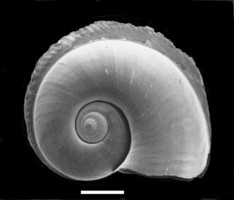
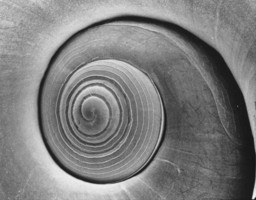
 Click on an image to view larger version & data in a new window
Click on an image to view larger version & data in a new windowFigure. Scanning electron micrographs of the shell of a 2.0 mm Atlanta helicinoidea, viewed from the right side (above) at low (left) and high (right) magnifications, and with the shell tilted from the posterior end (below left) and with the spire at about a 60° ventral tilt (below right). Scale bar in first SEM = 0.5 mm. ©
 Click on an image to view larger version & data in a new window
Click on an image to view larger version & data in a new window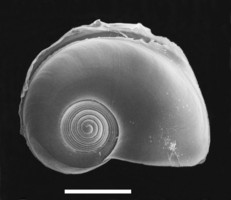
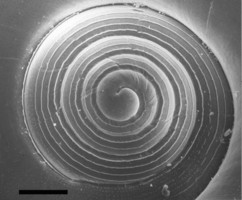
 Click on an image to view larger version & data in a new window
Click on an image to view larger version & data in a new window Click on an image to view larger version & data in a new window
Click on an image to view larger version & data in a new window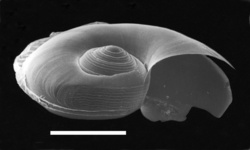
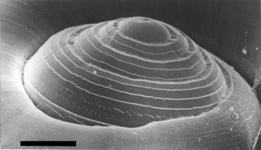
 Click on an image to view larger version & data in a new window
Click on an image to view larger version & data in a new windowFigure. Scanning electron micrographs of the shell of a 1.4 mm diameter Atlanta helicinoidea, viewed from the right side (above) at low (left) and high (right) magnifications, and at about a 60° tilt (below) at low (left) and high (right) magnifications. Scale bars = 0.5 mm (left) and 0.1 mm (right). ©
- Coloration
- Keel base coloration variable, ranging from clear to brown or yellowish brown
- Spire coloration dimorphic; either light purple (see first pair of photographs below) or light yellow to a tannish-yellow (see second and third individual photographs below)
 Click on an image to view larger version & data in a new window
Click on an image to view larger version & data in a new window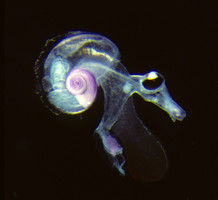
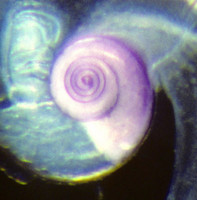
Figure. Atlanta helicinoidea, viewed from right side, with the body extended from the shell (left), and with the spire region magnified (right). © Roger R. Seapy
- Keel base coloration variable, ranging from clear to brown or yellowish brown
- Eyes type c, with a black, cup-shaped base (see title illustration and first color photograph above). This eye morphology is unique in the genus Atlanta
- Operculum type c (monogyre)
- Radula type I
Comments
Atlanta helicinoidea has been recorded in moderately low to low abundances in the northeastern Indian Ocean (Richter, 1974) and Hawaiian waters in the North Pacific (Seapy, 1990a and 2008). In Richter's study it ranked tenth of fifteen species, representing 3.2% of the total species count. In Hawaiian waters it ranked ninth of twelve species, accounting for 2.3% of the total count in one study (Seapy, 1990a), while in a subsequent study (Seapy, 2008) it ranked ninth of ten species (0.5% of the total) during a fall sampling period and seventh of fifteen (3.1% of the total) from a spring sampling period. In a study of vertical distributions and abundances (Seapy, 1990b) it occurred at densities of less than four individuals per 1,000 m3.
Atlanta helicinoidea is a moderately shallow-dwelling species. Off Hawaii it was recorded (Seapy, 1990b) between the surface and 90-140 m during the day and in the upper 90 m at night (although nearly all individuals occurred in the upper 45 m). A subsequent study (Seapy, 2008) was also conducted from the same location off leeward Oahu during spring and fall sampling periods. Diel vertical distributions were determined at three stations located 1, 5 and 15 nmi from shore. Maximal depths of 60-80 (at the 1 and 15 nmi stations) and 80-100 m (at the 5 nmi station) were recorded for A, helicinoidea during the day, with limited evidence of upward migration at night (20 m shallower at all three stations). Abundances decreased by five fold from oceanic (15 nmi station) to neritic (1 nmi station) waters.
References
Richter, G. 1974. Die Heteropoden der "Meteor" Expedition in den Indischen Ozean 1964/65. "Meteor" Forschungs-Ergibnisse Ser. D, No. 17, pp. 55-78.
Richter, G. 1987. Zur Kenntnis der Gattung Atlanta (III), Atlanta inflata, A. helicinoides, A. echinogyra und A. plana (Prosobranchia: Heteropoda). Archiv für Molluskenkunde 117: 177-201.
Seapy, R. R. 1990a. The pelagic family Atlantidae (Gastropoda: Heteropoda) from Hawaiian waters: a taxonomic survey. Malacologia 32: 107-130.
Seapy, R. R. 1990b. Patterns of vertical distribution in epipelagic heteropod molluscs off Hawaii. Marine Ecology Progress Series 60: 235-246.
Seapy, R. R. 2008. Offshore-onshore and vertical distributional patterns of heteropod mollusks off leeward Oahu, Hawaii. Marine Biology 154: 985-995.
Title Illustrations

| Scientific Name | Atlanta helicinoidea |
|---|---|
| Location | Hawaiian waters |
| Specimen Condition | Live Specimen |
| Sex | Female |
| Life Cycle Stage | adult |
| View | right side |
| Image Use |
 This media file is licensed under the Creative Commons Attribution-NonCommercial License - Version 3.0. This media file is licensed under the Creative Commons Attribution-NonCommercial License - Version 3.0.
|
| Copyright |
©

|
About This Page

California State University, Fullerton, California, USA
Correspondence regarding this page should be directed to Roger R. Seapy at
Page copyright © 2011
 Page: Tree of Life
Atlanta helicinoidea . Atlanta helicinoides .
Authored by
Roger R. Seapy.
The TEXT of this page is licensed under the
Creative Commons Attribution License - Version 3.0. Note that images and other media
featured on this page are each governed by their own license, and they may or may not be available
for reuse. Click on an image or a media link to access the media data window, which provides the
relevant licensing information. For the general terms and conditions of ToL material reuse and
redistribution, please see the Tree of Life Copyright
Policies.
Page: Tree of Life
Atlanta helicinoidea . Atlanta helicinoides .
Authored by
Roger R. Seapy.
The TEXT of this page is licensed under the
Creative Commons Attribution License - Version 3.0. Note that images and other media
featured on this page are each governed by their own license, and they may or may not be available
for reuse. Click on an image or a media link to access the media data window, which provides the
relevant licensing information. For the general terms and conditions of ToL material reuse and
redistribution, please see the Tree of Life Copyright
Policies.
- First online 07 October 2009
- Content changed 23 July 2011
Citing this page:
Seapy, Roger R. 2011. Atlanta helicinoidea . Atlanta helicinoides . Version 23 July 2011. http://tolweb.org/Atlanta_helicinoidea/28762/2011.07.23 in The Tree of Life Web Project, http://tolweb.org/





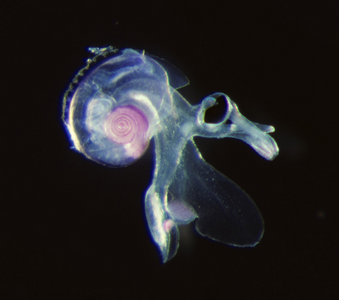
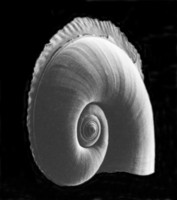
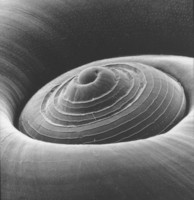
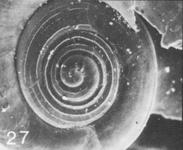
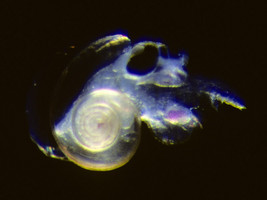
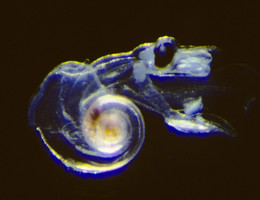
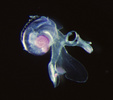


 Go to quick links
Go to quick search
Go to navigation for this section of the ToL site
Go to detailed links for the ToL site
Go to quick links
Go to quick search
Go to navigation for this section of the ToL site
Go to detailed links for the ToL site